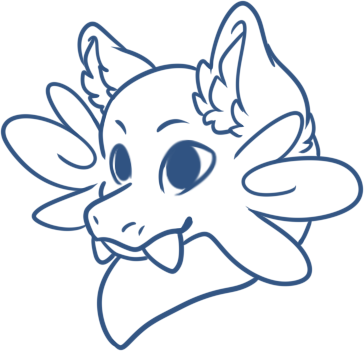Isomara communicate using vocal calls, body positioning, and a rudimentary symbol system. Early Isomara communicated primarily through vocalizations of various howls, huffs, and growls and quickly adapted to their growing knowledge. The posture and angle of brows, mouth, ears, and other body parts assist in conveying emotion and meaning with the vocalizations.
Auditory Communication
An Isomara's vocal cords are fully developed after roughly six months of age, granting the ability to speak between one another. Younger Isomara will often revert to native sounds of various "Arwoos", "Aroofs", and "Arrrrs". Isomara are rather calm and mild-mannered, but if one or more gets riled up you better believe you'll hear a cluster of playful "Arooooooos".
Other times these native calls are heard to signify trouble and anxiety. A series of short loud howls signify an alarm of danger or caution to other local isomara. Isomara are cautious not to alert any Memics or other easily angered inhabitants in potential proximity though, so it is ill-advised to sound an alarm in some biomes unless an emergency.
Due to their huge canine teeth, they all have varying degrees of lisps when speaking and some calls can have a whistle-like sound depending on teeth size and alignment.
Nonverbal Communication
While lanky with at times clumsy and over-sized paws an Isomara's body can express a wide range of intentions and behaviors. Expressing intention can be restricted as certain traits have more limited movement.
An aggressive, cautionary, or fearful emotion can easily be expressed through the eyes, ears, and position of the mouth. Direct stares usually read as annoyance or anger while avoiding eye contact can put off a sense of fear or discomfort.
Reading body language has become a sort of nuance skill that not all can pick up nowadays especially as Isomara have a wide range of body traits. The common average ears are easy to read as they have a wide range of movement with forward facing being alert and often associated with positive intentions, while ears flattened and turned away is worry or fear. Ear types like bat and fold have more limited movement making those traits a lot more difficult to read for intention.
The entire muzzle of an Isomara gives off plenty of social cues when not in verbal conversation. Teeth bared, nostrils flared, with the creases of the mouth turned down are easily read with negative connotations.
expressive characteristic Examples
| Trait Type | Neutral / Positive | Alert / Aggressive | Cautious / Fearful |
|---|---|---|---|
| Eyes |
Calm, large iris/pupils, average amount of eye contact |
|
Avoids eye contact, looks away often, partially closed lids |
| Ears |
|
|
|
| Mouth & Nosrils |
nostril and maw relaxed, content smile |
|
|
| Head & Neck |
head comfortably above or slightly resting on the curve of the neck. |
head held high and positioned forward ever so slightly, stretched out |
Neck is extended with head back. Many will also arch their neck like this in aggression as if to snap back |
| Body & Tail |
While standing the body is loose and fluid with their guard down. Tails wisk in large gradual movements freely. Wings will take comfortable positions. |
Tall to pose a threat or arched with limbs broadly to initiate an attack. Tails will stay still and tall or at times madly flicker. Wings flurry and ready to take flight |
Crouched, low to the ground, appears weak and unsure. Tail tucked or lay on the ground. Wings will fold to the sides of the body. |
Visual Communication
As the Isomara species continues their intellect, general knowledge, and skills grow, change, and ultimately form their society. Only in recent times have Isomara begun to develop a written language albeit severely limited to a small amount of symbols. These symbols are not used nor even taught to a majority of Isomara as there is simply no need. Travel and way of mouth are often faster and easier to convey news, but sigils have their uses and those who acknowledge this fact have begun to teach and draft new sigils into the island's history.
Sigils
Sigils represent specific words and concepts. When one is found to need a new sigil, a design is drafted and revised by fellow Isomara of the village. After the design is roughed it must go through initial village approval, then the sigil will need to be reviewed by two of the nearest villages and have a majority of okay from each village. The primary guidelines when it comes to making a new sigil are 1. How useful it is, 2. How frequently used could it be, and 3. It needs to be simple to memorize, but unique and identifiable no matter the orientation.
Sigils are often carved on the bark of trees and cave entrances to identify danger in the area and some mineral locations. There are a small amount of agreed-upon sigils on the island, but they still are rarely used and some villages have a lot of pride and refuse to adopt a specific sigil at times.
Teaching and spreading the word of new symbols is often done by drawing the sigil on a small stone or sand dollar. The paint created is a less permanent mixture than that used in dyed whites. This prevents tampering of the symbol. The mixture dulls much sooner, so any new paint applied will be noticeable. The pebbles and sand dollars are given out to those who are seen as scholars and teachers of each village. Parents and isoling alike are often given the new sigils to hold onto. Villages who do not initially approve of the sigil design have been seen to accept bribes of sand dollars with the painted sigil (This was the case for the Blepper sigil in a couple of villages. A majority of one village did not see the point of giving such a useless creature a sigil while another village simply did not like the design, but both villages took to the new symbol after a bribe).
   |
| From left to right: Give, Blepper, Flame |
Numeric Sigils
These sigils were created for use in counting and displaying amounts. The numerals are typically overlapped to save space and represent larger numbers. If it is pertinent to display two separate amounts then do not overlap these numeric sigils.
A single long line represents zero (0). This line can be split into four quadrants to represent the ones, tens, hundreds, and thousands places. The ones place is always drawn upper right quadrant of the line. The Tens place is in the upper left, then hundreds in the lower right, and lastly thousands are in the lower left. If a number is to go beyond 9,999 then the original zero line is lengthened for an additional left and right quadrant below the hundreds and thousands. This new lowest right quadrant is the ten thousands place and left the hundred thousands place.
 |
| Numbers zero through nine as they appear in the ones place. |
Zero (0) through nine (9) remain visually consistent no matter what quadrant they are placed in. The orientation is the only thing that changes. A good rule of thumb taught to Isolings when learning to read and write numeric sigils is to start at the zero line and draw outward. For the symbols of two (2), four (4), and eight (8) split the quadrant in half and start at that center point in the quadrant.
(8) split the quadrant in half and start at that center point in the quadrant.
Drawing the numeric sigils vertically became the most popular way as carving on tree trunks and tall stones was common and putting downward force was easier for the initial zero line, but there are some villages and Isomara who prefer to draw the numerical sigil sideways. When drawing sideways the numeric places remain the same with the ones placed in the top right and thousands in the bottom left. Always go from right to left, top to bottom.




 Uncommon Ribbon | Common Average
Uncommon Ribbon | Common Average
 Uncommon Ribbon | Common Average
Uncommon Ribbon | Common Average
 Rare Perked | Common Average
Rare Perked | Common Average









